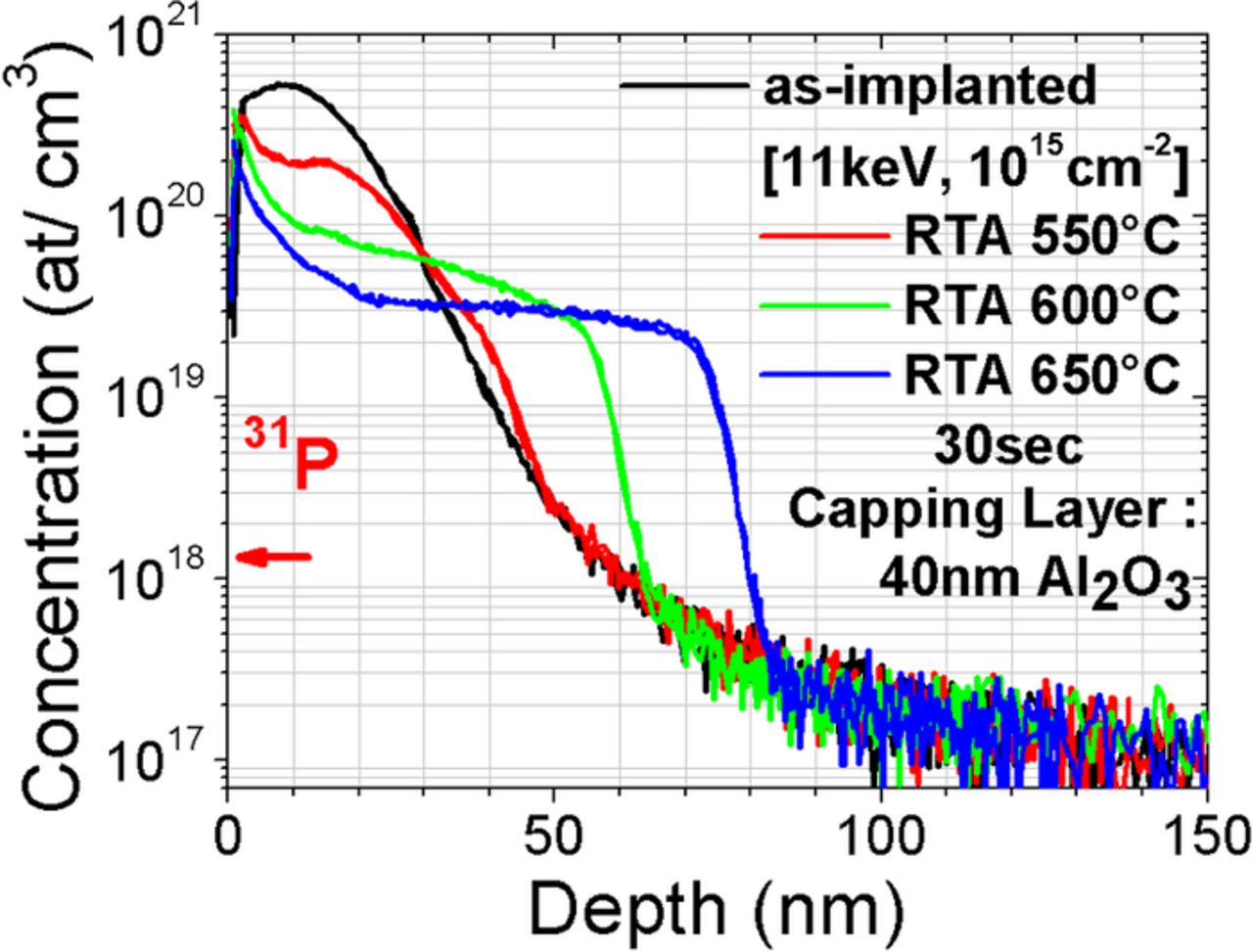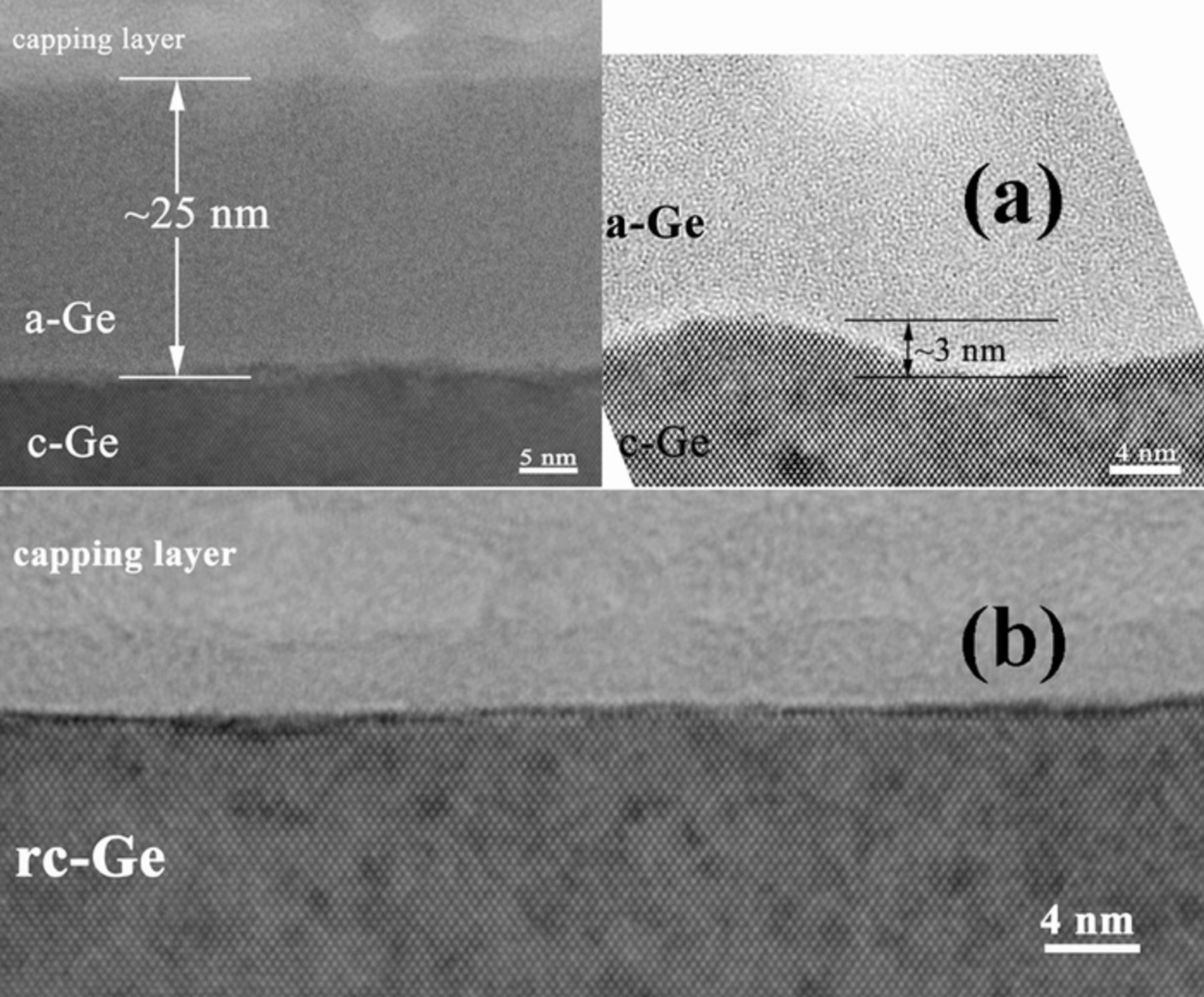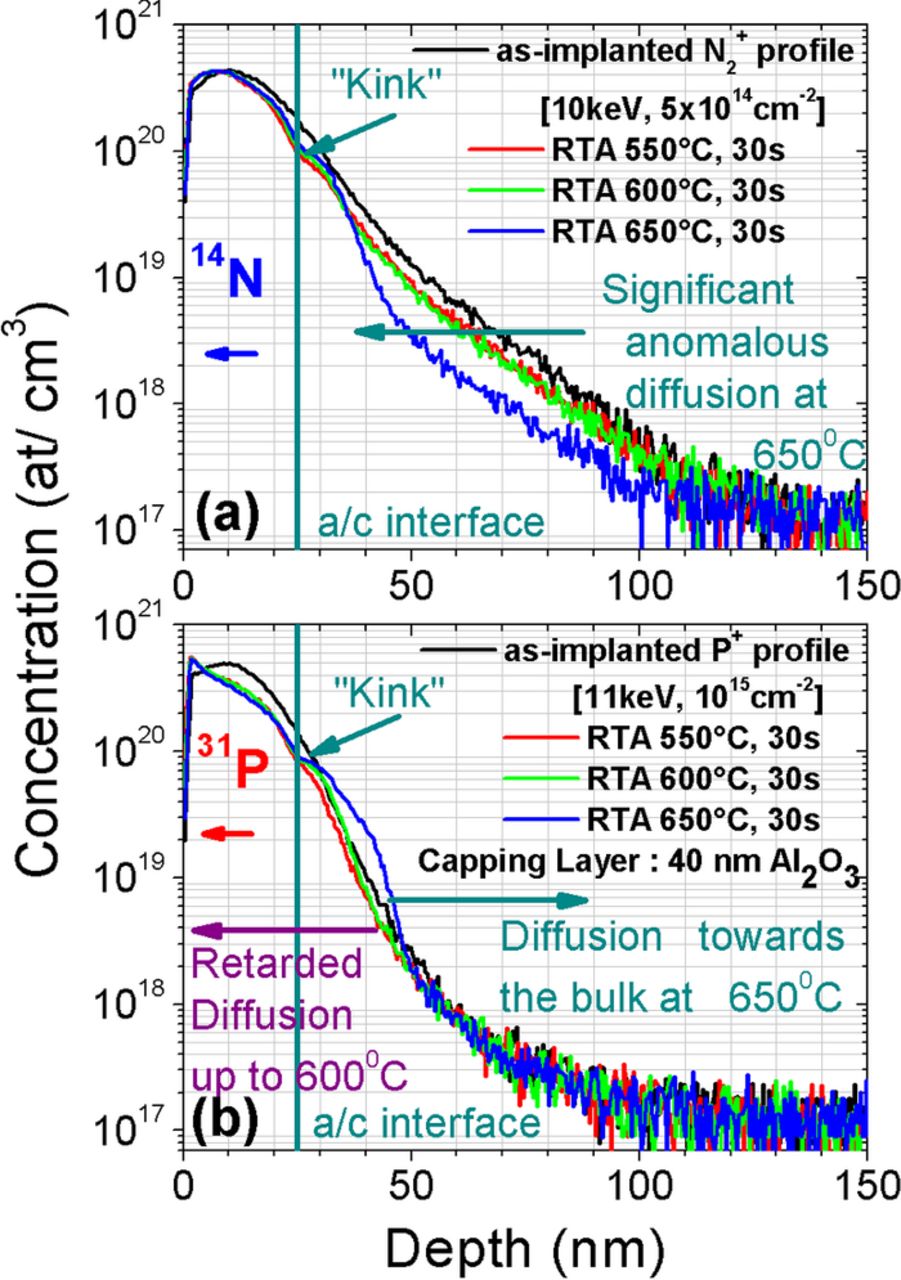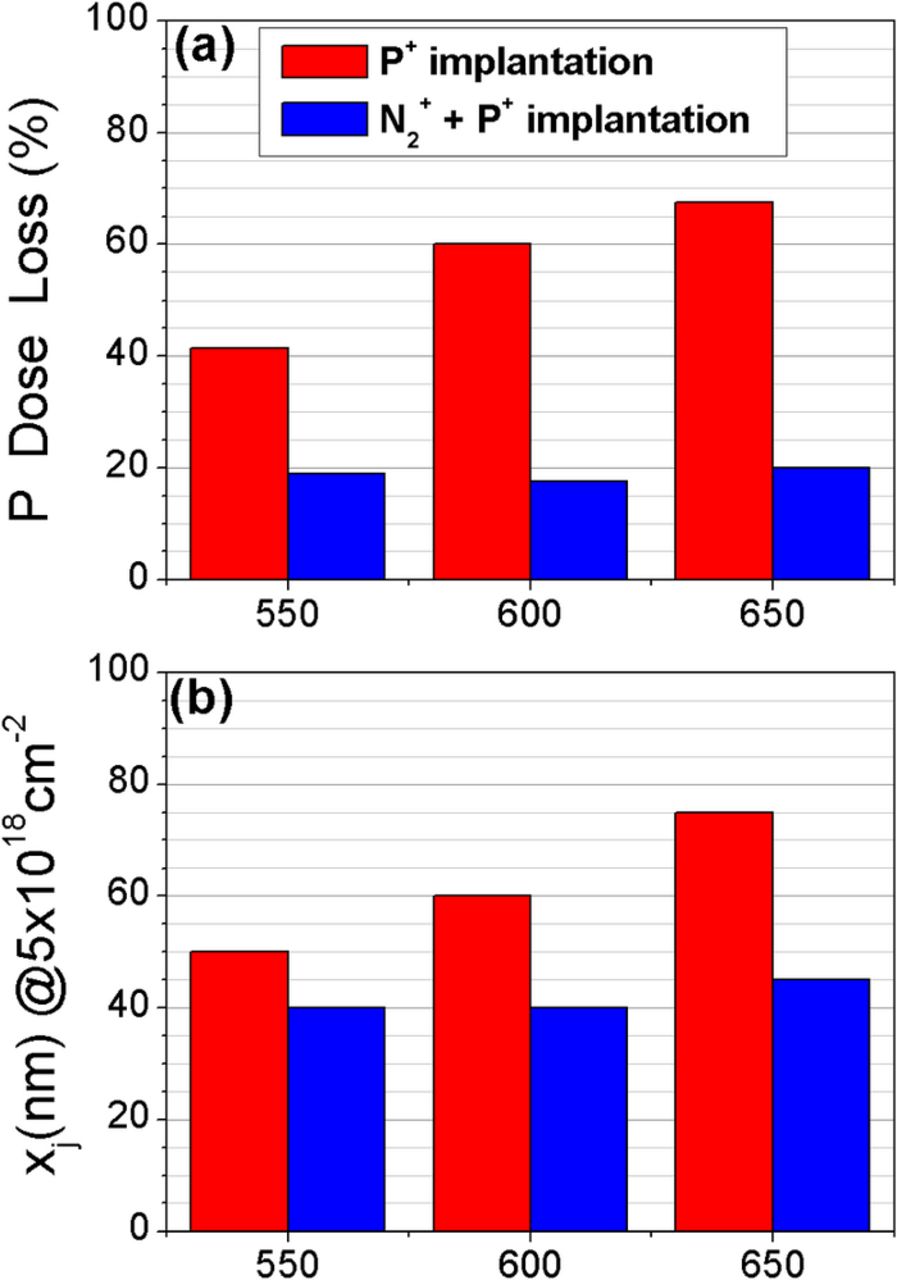Abstract
In this work an effective diffusion suppression of low energy – high dose (11 keV/1015 cm−2) phosphorous in 10 keV/5 × 1014cm− 2 N2+-implanted p-germanium is demonstrated. Diffusion of both species after isochronal 30 sec RTA annealing at 550–650°C has been studied by SIMS in the presence of Al2O3 as surface capping layer. Nitrogen shows anomalous non-Fickian diffusion towards the Al2O3/Ge interface, while phosphorous dose loss and diffusion to the bulk are strongly suppressed in comparison to Ge substrate without nitrogen implantation. Possible physical mechanisms (involving phosphorous-vacancies or phosphorous-nitrogen complexes, and end-of-range interstitials) that explain this result are presented and discussed.
Export citation and abstract BibTeX RIS

This is an open access article distributed under the terms of the Creative Commons Attribution Non-Commercial No Derivatives 4.0 License (CC BY-NC-ND, http://creativecommons.org/licenses/by-nc-nd/4.0/), which permits non-commercial reuse, distribution, and reproduction in any medium, provided the original work is not changed in any way and is properly cited. For permission for commercial reuse, please email: oa@electrochem.org.
Systematic studies during the last decade revealed that the fast diffusion of n-type dopants (P, As, Sb) in Germanium constitutes a major drawback for the establishment of deeply scaled n-channel Ge MOSFETs (Metal-Oxide-Semiconductor Field Effect Transistors) technology. Fast n-type dopant diffusion in Ge is considered to occur via a vacancy-mediated mechanism and is usually accompanied by significant dose loss (due to out-diffusion) and clustering phenomena preventing thus the formation of shallow and highly activated n+/p source/drain junctions.1
Phosphorous has the highest equilibrium solubility limit (2 × 1020 cm−3) among the common n-type dopants in Ge.2 Consequently significant research efforts have been focused to the study of P macroscopic diffusion behavior as a function of the implantation and annealing conditions, as well as the nature of a capping layer (CL) on the Ge surface.3–7 In parallel, techniques which could suppress P diffusion and/or enhance its activation level have been pursuit, most representative of which are co-implants with carbon or fluorine,8,9 co-doping with other n-type dopants (such as arsenic and antimony)10,11 and low temperature metal-induced dopant activation.12
Nitrogen constitutes a significant element, which has been used in silicon front-end processes. Indeed, the anomalous nitrogen interstitial-mediated diffusion has been successfully employed for the suppression of dopant enhanced diffusion in silicon.13 Although this practice has been proposed2 in order to suppress P diffusion in Ge, there was not up to date a systematic study on the subject. The experiment of Ref. 2 simply demonstrated P diffusion suppression after medium energy implants (40 keV P+ followed by 65 keV N) and subsequent annealing at 600°C for 2 sec without referring on simultaneous nitrogen diffusion. Recent results on nitrogen diffusion in Ge14 revealed again an anomalous diffusion which was attributed to an interstitial mediated mechanism. This nitrogen diffusion towards the Ge surface seems to depend on the formation of nitrogen-Ge point defects (possibly interstitials) clusters at the end of range (EOR) region. Such clusters between nitrogen atoms and Ge interstitials could suppress low energy P diffusion in Ge. During the initial stages of the annealing, EOR excess Ge interstitials absorption by the capping layer/Ge interface15 could be prevented by the formation of NnIm (I = interstitial) clusters. The increase of the annealing temperature could result in a local interstitial supersaturation caused by cluster dissolution, which may retard P vacancy-mediated diffusion. This physical reasoning was the initial motivation for the present study.
A Czochralski p-type (100) Ge wafer from a batch with resistivity ρ = 0.04–0.4 Ωcm, obtained from UMICORE has been used. One part of the wafer has been implanted with N2+ using the implantation conditions of Ref. 14 [energy 10 keV, dose 5 × 1014 cm−2 (total N dose 1 × 1015 cm−2)], while the other served as reference substrate. Both parts were subsequently implanted with 11 keV P+ at a dose of 1015 cm−2. Phosphorous implantation conditions have been chosen via preliminary simulations in order to match both the dopant and nitrogen profiles in terms of projected range (Rp) and peak concentration. Implantations have been performed in a VIIsta Trident low energy implanter at 0°tilt /0°twist. After implantations a 40 nm Al2O3 capping layer has been deposited at 300°C on the two wafer parts using a Savannah-100 ALD (Atomic Layer Deposition) system by Cambridge-Nanotech/USA to avoid Ge substrate loss.6 Samples from both wafer parts have been simultaneously rapid thermal annealed (RTA) for 30 sec at 550, 600 and 650°C in N2 ambient. Phosphorous and nitrogen distributions directly after implantation and after annealing have been studied by dynamic SIMS (Secondary Ion Mass Spectrometry) measurements using a CAMECA SC-Ultra apparatus (the capping layer has been removed from the samples by immersion in diluted HF solution for SIMS study) with Cs+ sputtering beam at 1 keV impact energy. Analyses were carried out in negative polarity monitoring 74Ge− as matrix reference signal and the secondary ion signals of nitrogen and phosphorous as 70Ge14N− and 70Ge31P− molecular ions (all 70Ge14N− and 70Ge31P− secondary ion signals have been normalized point by point to the 74Ge− matrix signal). Two measurements have been carried out for each profile differing only in raster size (300 × 300 or 400 × 400 μm2). Depth calibration has been obtained by measuring the final sputtered craters using a Tencor P6 mechanical profilometer. The relative sensitivity factors (RSFs) for the depth profiles quantification have been obtained on the as-implanted samples with the known implantation doses. Structural characterization of the as-implanted and annealed substrates has been performed by conventional and High Resolution Transmission Electron Microscopy (TEM, HRTEM) using a JEOL 2011 transmission electron microscope.
Figure 1 shows the P SIMS profiles in the reference Ge substrate where P diffusion takes place in Ge capped by an Al2O3 layer. The Ge substrate has been completely recrystallized after RTA at 550°C (TEM image not shown). The results indicate the typical extrinsic diffusion behavior of P at high implant doses. As the annealing temperature increases the evolution of the profile becomes "box-like" accompanied by the well-known pile-up effect at the capping layer/Ge interface. In parallel, out-diffusion via segregation at the Al2O3/Ge interface leads to significant P dose loss ranging between 40 - ∼70% at 550–650°C respectively. It has been reported6 that P dose loss depends on the composition of the capping layer deposited on the Ge surface with Si3N4 being much more efficient in preventing P out-diffusion as compared to SiO2. On the other hand the presence of Si3N4 enhances significantly P diffusion (which is concentration dependent at high doses). It should be mentioned that since P diffusion in Ge depends strongly on the CL material, a safe comparison between the data of Fig. 1 and previously reported data cannot be made. However, Ref. 4 (15 keV P+ at 3 × 1015 cm−2) reports a 60% dose loss after 1 sec RTA at 600°C with SiO2 as capping layer. This gives evidence that the Al2O3 effect on P diffusion is between those of silicon dioxide and nitride.
Figure 1. Phosphorous SIMS profiles after 11 keV/1015 cm−2 implant and RTA at 550–650°C in (100) p-Ge. For each profile two measurements with different raster size (300 × 300 or 400 × 400 μm2) overlap showing excellent reproducibility of the results.
Figure 2a presents conventional and high-resolution TEM images of the N2+ + P+ as-implanted Ge substrate after the deposition of the Al2O3 capping layer. The Ge amorphous layer extends to ∼25 nm from the capping layer/Ge interface and the a/c Ge interface shows a significant roughness of ∼3 nm. After annealing at 550°C for 30 sec the Ge substrate has been completely recrystallized as shown in Figure 2b. In this case the absence of extrinsic extended defects beyond the former a/c interface (image not shown) is expected since literature reports justify their dissolution in Ge in the temperature range of the present experiment taking also into account the proximity of the EOR region to the alumina/Ge interface.15–18 Based on Si experience19 (and the results of Ref. 14 in the case of Ge) this could be also attributed to the presence of nitrogen in the substrate and its trend to agglomerate with interstitials thus suppressing the evolution of EOR extrinsic extended defects.
Figure 2. (a) Conventional and High-Resolution cross-section TEM images of N2+ (10 keV/5 × 1014 cm−2) + P+ (11 keV/1015 cm−2) as-implanted (100) p-Ge substrate after the deposition of a 40 nm Al2O3 capping layer at 300°C. Ge amorphization extends to ∼25 nm from the capping layer/substrate interface. (b) After RTA at 550°C for 30 sec the substrate has been completely recrystallized.
Figure 3 shows Nitrogen and Phosphorous profiles in the co-implanted Ge substrate. In the as-implanted state both distributions are perfectly matched at RP ∼ 10 nm. The as-implanted nitrogen distribution exhibits an extended tail due to channelling effects.14 As a result the as-implanted phosphorus distribution is enveloped by that of nitrogen.
Figure 3. (a) Nitrogen and (b) Phosphorous SIMS profiles after 11 keV/1015 cm−2 P+ implant in 10 keV /5 × 1014 cm−2 N2+ - implanted (100) p-Ge and after RTA at 550–650°C. Only the measurements with raster size 400 × 400 μm2 are presented. We observe that both as-implanted profiles are matched at a projected range Rp ∼ 10 nm.
During annealing nitrogen exhibits the well-known non-Fickian anomalous diffusion behavior towards the alumina / Ge interface as described in detail in Ref. 14. At 550–600°C the diffusion is negligible and increases significantly after 650°C annealing. Nitrogen diffusion is accompanied by the formation of a distribution "kink" at the former amorphous/crystalline (a/c) interface, similar to the already reported "EOR pileup" attributed to N-Ge intersitial clusters.14 However, the annealing time is quite short and limits the diffusion of the entire distribution which results in the absence of the "secondary pileup" far beyond the a/c interface.14 The nitrogen profile within the former amorphous Ge layer remains almost immobile, which lead to a constant dose loss of ∼ 10% for all temperatures examined.
The most impressive result comes from P diffusion, which is strongly suppressed not only compared to the results of Fig. 1, but also to literature data at similar experimental conditions.3–5 The overall picture is that both profiles are strongly interrelated with nitrogen diffusion giving the trend. In particular, at 550–600°C P does not diffuse to the bulk at all. In contrast we observe a kind of retarded phosphorous diffusion since its profile extends slightly less than the as-implanted one (this seems not a matter of measurement uncertainty, since repetition of the measurements performed at different raster size shows the same result). The results therefore indicate that the phosphorous profile is bounded to that of nitrogen, following its movement towards the CL/Ge interface. The characteristic "kink" at the former a/c interface appears also in phosphorous profiles after annealing at 550°C. As the annealing temperature increases to 650°C, P profile below the a/c interface begins diffusing slowly to the bulk as nitrogen anomalous diffusion towards the surface increases. Finally, we observe that phosphorous profile within the former amorphous Ge layer remains also almost immobile, which lead to a constant dose loss of ∼20% for all temperatures examined. Figure 4 summarizes the influence of nitrogen on P diffusion in terms of dose loss and junction depth in comparison to the results extracted from Figure 1.
Figure 4. (a) Comparison of phosphorous dose loss during RTA annealing between P+ monodoping implant and N2+/P+ co-implant in (100) p-Ge. We observe a significant P dose loss reduction in the presence of nitrogen. (b) Comparison of the corresponding junction depth estimated at 5 × 1018 cm−3. Nitrogen managed to block effectively P fast diffusion in Ge.
The following alternative physical mechanisms can be employed for the explanation of phosphorous diffusion suppression in the presence of nitrogen.
(a) P diffusion suppression only due to nitrogen
Ge vacancies clustering
The formation of NnVm (V = vacancy)20 clusters could reduce vacancy concentration participating in P diffusion and simultaneously immobilize part of the nitrogen profile. This argument has been also used in Ref. 2 in order to explain P diffusion suppression when co-implanted with N in Ge. The present experimental results suggest that the configuration and stability of the NnVm clusters should depend on nitrogen concentration, with the less stable formed beyond the a/c interface. Dissolution of the later at 650°C could lead to simultaneous P and N diffusion. However, the study of nitrogen diffusion in Ge14 didn't give any evidence of such clustering mechanism, which could prevent N diffusion within the former amorphous layer. On the contrary there is a strong evidence of clustering between N atoms and Ge self-interstitials at the EOR region. Consequently this hypothesis hardly justifies the EOR "kink" formation in the distributions of both species after annealing, which is also observed in the case of nitrogen (Ref. 14) but not observed in the case of phosphorous single-doping diffusion in Ge (Fig. 1).
(b) P diffusion suppression only due to nitrogen
phosphorous clustering
Theoretical calculations20 predict also the formation of P-N clusters in Ge. This could explain better the strong connection between both P and N profiles during annealing. Clustering could take place during the initial movement of nitrogen at 550°C. It appears more favorable in the high concentration region of the profiles thus preventing strong P and N out-diffusion. In this case the "kink" formation of the N distribution could be explained as follows: as the N tail diffuses towards the CL/Ge interface, it encounters the high concentration immobile part of the distribution, which, acting as a diffusion barrier, results to the formation of a pileup. Simultaneous clustering with P atoms could also explain phosphorous initial retarded diffusion beyond the a/c interface and the formation of a similar "kink" at the same region. As the annealing temperature increases to 650°C, less stable clusters beyond the a/c interface dissolve. This leads to diffusion of the corresponding part of P profile to the bulk and to enhanced anomalous diffusion of N tail profile accompanied by a slight increase of the corresponding "kink" height. However, this approach presumes also the existence of P-N clusters of different configurations and stability dependent on P and N concentrations. Up today theoretical calculations20 refer only to the formation of PN clusters with lower binding energy as compared to the variety of NnVm clusters examined. A more systematic theoretical study is necessary to support this scenario. Finally, the role of Ge self-interstitials at the EOR region which, according to Ref. 14, may affect N diffusion should not be ignored.
(c) A mixed mechanism which takes into account the role of EOR interstitial supersaturation
The third approach is closer to the initial motivation for the present work. The independence of N and P diffusion and dose loss on the annealing temperature within the former amorphous region is a strong evidence of a clustering phenomenon more probably between N and P atoms. This is mainly supported by the results of Ref. 14, according to which a nitrogen dose loss dependence on the annealing temperature in the absence of co-implanted P should be expected. The same is valid for P single-doping diffusion according to the results of Figures 1 and 4. Beyond the a/c interface a Ge interstitial supersaturation is created after implants.15,16 During annealing an interstitial gradient is maintained between the EOR region and Al2O3/Ge interface, which act as a sink, being the driving force for N anomalous diffusion.14 In parallel, nitrogen clustering with part of Ge excess interstitials prevents their absorption by the Al2O3/Ge interface and leads to the formation of the characteristic "kink" of N distribution at the EOR region.14 The maintained interstitial supersaturation is responsible also for the initial retarded diffusion of P observed up to 600°C and to the formation of the characteristic EOR "kink" as low concentration diffusing part of its profile encounters the immobile high concentration one. As the annealing temperature increases, progressive NnIm cluster dissolution and the simultaneous decrease of EOR interstitial supersaturation could explain both the significant N anomalous diffusion and the slow P diffusion to the bulk. This physical mechanism presumes the formation of NnIm clusters at the EOR region. Despite the lack of theoretical calculations, one cannot exclude the formation of clusters between N and Ge interstitials (or even between N, Ge interstitials and P). In addition to the experimental study of N diffusion (Ref. 14), this is also supported by the studies of arsenic and phosphorous diffusion when co-implanted with fluorine in Ge.9,18 In the later works the formation of FI clusters in the presence of an interstitial supersaturation at the EOR region has been verified experimentally as well as by theoretical calculations.
Regardless of the exact mechanism of nitrogen action, the method has been proved extremely beneficial in suppressing phosphorous dose loss and fast diffusion in Ge. The presented results are very encouraging taking into account the implantation conditions and the proximity of P distribution to the Ge surface. A comparison between the presented results to the recently reported on fluorine impact on P diffusion in Ge,9 suggests that nitrogen is probably more effective in suppressing P diffusion as compared to fluorine. This could be attributed to the different way each element acts (fluorine reduces vacancy concentration by formation of FnVm clusters while the most probable mechanism for nitrogen action is the formation of P-N complexes) in combination to slower out-diffusion trend of N as compared to F.14,9 The method offers great flexibility in terms of implantation (energy and dose) and subsequent annealing (flash or spike annealing) conditions towards the formation of more abrupt and highly active n+/p junctions. A series of experiments (including isothermal annealing of variable duration, change of the capping layer to Si3N4 or SiO2, electrical measurements for accurate extraction of P activation level) accompanied by theoretical work are already in progress in order to test the proposed microscopic mechanisms involved for process optimization.





